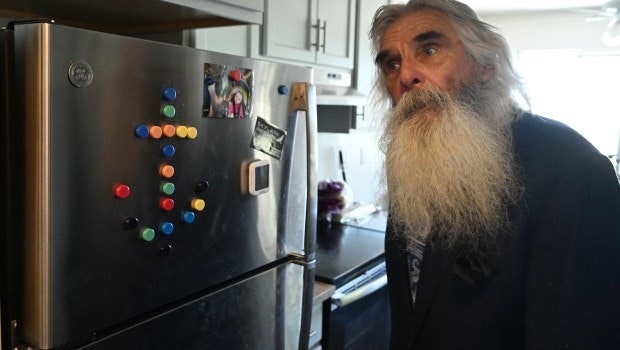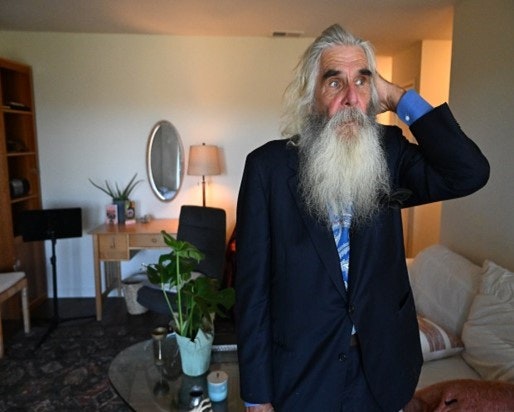Richardson Bay Housing Program Eases ‘Anchor-Outs’ Ashore
By KRISSY WAITE | kwaite@marinij.com
UPDATED: July 15, 2024 at 6:27 a.m.

For the first time in 40 years, former “anchor-out” Peter Romanowsky has a refrigerator.
“I bought ice cream,” he said.
Romanowsky was living on his boat anchored in Richardson Bay until several weeks ago, when he moved into a one-bedroom apartment in Larkspur — only a few miles from where he lived before moving into a boat. His housing is part of the Richardson’s Bay Regional Agency housing program, which has recently transitioned some participants into the federal housing voucher program.
“We created this whole program, it has not existed before,” said Marin County Supervisor Stephanie Moulton-Peters. “So it’s very gratifying for me to see this final step put in place and be successful with these permanent federal vouchers. You always hope for the best as you’re creating new programs. I certainly felt this was a solid approach, but it is very gratifying to see it all work out the way we hoped and planned that it would.”

Many mariners have lived on their boats in the bay for decades, despite a law that prohibits boats from anchoring there for longer than 72 hours. In 2016, there were 240 anchor-outs. As of June 12, there were 25 boats on the bay.
In 2021, the agency reached a settlement with the San Francisco Bay Conservation and Development Commission that states illegally anchored vessels would be removed by October 2026. The agreement was struck after threats of enforcement action by the commission.
As of late June, the agency had issued 12 housing vouchers, with 13 clients housed. Three people have transitioned into the Section 8 Federal Housing Choice Voucher initiative. The federal program is a permanent source of subsidized housing support for people, where the RBRA voucher is only for one year.
Romanowsky, a pastor, moved to Marin County 60 years ago from southern California. He said a rough divorce left him with nowhere to go. He did, however, have a boat, and he moved onto the bay. Low living costs, and no rent, kept him on the boat.
“After 60 years, I’m back in my old neighborhood,” Romanowsky said. “It’s all coming up roses.”
Brad Gross, executive director of the Richardson’s Bay Regional Agency, said he believed some people on the anchorage had their doubts that the federal program would come through. Now that deadlines are coming up and the program is running, more people seem interested.
“People were skeptical, but now they are seeing it,” Gross said. “People have done it, now they’ve been housed, and now we’ve just had three federal vouchers issued that kind of closes the whole loop on the program. I think everybody has been waiting to see. They were skeptical of the timing.”
The federal vouchers also free up three more RBRA housing vouchers. One person is in the intake process and one person is actively looking for housing. Within two months, the agency hopes to have housed 20 people through the program, according to Will Reisman, a spokesperson for the agency.
Romanowsky, who said he was the longest-living anchor-out, is 75 and has arthritis in his back. He said he decided to participate in the program for his health and safety. Living on the anchorage is like “living like a pirate,” and storms are dangerous on a boat.
“I decided to take the deal because at my age, with my back, I can’t keep living out there,” Romanowsky said.

Romanowsky said a defining factor in changing his mind about the program was mindset: It’s a trade, or relocation, not welfare. He said many people living in the anchorage won’t take handouts, so the program can seem off-putting. Additionally, he said the case workers were pivotal in his decision. Previously, he refused to even talk to harbormasters or agency representatives.
“I thought no one’s ever come to me for nothing, let them come to me,” Romanowsky said.
And they did. Caseworkers with the agency from Episcopal Community Services, along with other supportive services workers, would paddle out to his boat and bring him things like candy bars and supplies, and it eventually won him over. Romanowsky said the whole process took about a month, and the caseworkers helped him with every step, even getting emotional support credentials for his dog, Toby.
Gross said caseworkers are essential to the program’s success, but the agency only has one because of limited funding. Even if more people wanted to participate, staff can only process one to three people at a time.
“We sure could use some more funding,” Gross said. “We have an appropriate amount of funding for what our vision is. If anything, I would like to be able to get more funding, get more staff and help more people. The more funding we get, the more staff we can get, the more people we can get housing for.”
Even though Romanowsky is still sleeping on the couch — a mattress is a hard adjustment after four decades of sleeping on a bunk — he said he is living the “American dream.” He plans to write a book about his time on the anchorage, and even return to the water for some short, fun trips, now that he has a home base.
“I’m happy as a lark in Larkspur,” he said.
Originally Published: July 5, 2024 at 10:13 a.m.
